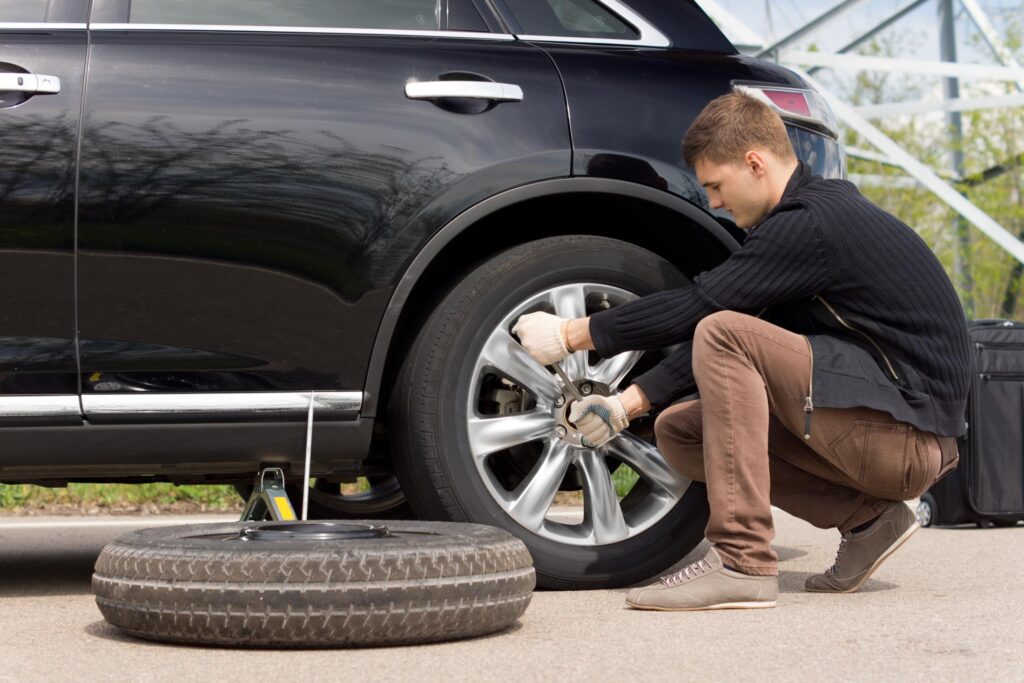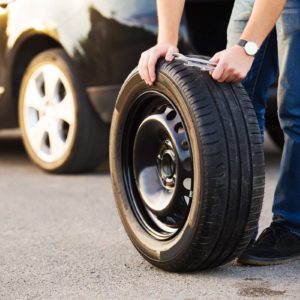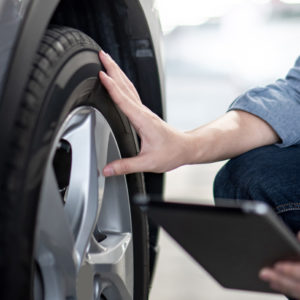Tire problems can be unpredictable. One moment you could be enjoying a scenic drive, and the next you could be dealing with a blown-out tire. That’s why it’s important to keep a spare in your trunk or under the vehicle where it’s designed to reside.
However, spare tires tend to differ from the tires your vehicle came with. Besides height, weight, and tread depth, another way they’re different is the (pounds per pressure) PSI they have.
How Much PSI Should a Spare Tire Have?
Your spare tire should hover around 35 to 60 PSI, but the actual amount depends on the spare tire. For comparison, regular OEM tires maintain a PSI level of 30 to 40, depending on the vehicle.
PSI is the unit of measurement for the air pressure inside your tire. Ensuring your tires have the appropriate PSI level can help prolong their lifespan, as it maintains the tread, limiting the wear and tear on your tires.
Why Do Spare Tires Have Higher PSI Than Regular Tires?

Spare tires tend to lose air over time. They have higher PSI than regular tires so that, when you use them, their air pressure is at the right level for driving.
If you haven’t used your spare for a long time, ensure it still has the ideal PSI before using it. If it doesn’t, you can inflate it in gas stations, auto repair shops, or tire service centers.
Why Monitor Spare Tire PSI?
Pay more attention to your spare tire’s PSI for the following:
Guarantee Vehicle Stability
Since spare tires in the trunk are often smaller than regular ones, ensuring they have the appropriate PSI makes up for the deficiency. This evenly distributes the vehicle’s weight, making it more stable when driving.
However, spare tires for pickup trucks and SUVs that are under the rear of the vehicle are full-sized. The size differs depending on what vehicle you’re driving.
Spare tires for pickup trucks and SUVs that are under the rear of the vehicle are full-sized. The size differs depending on what vehicle you’re driving.
–Anthony Harlin, ASE Certified Master Automobile Technician
Promote Fuel Efficiency
Under-inflated tires affect the gas mileage for every PSI drop, so keeping it inflated to the recommended pressure helps improve the car’s fuel economy.
You can find the ideal PSI level on the markings on your spare tire, the tire placard in the driver door jamb, the passenger left door jamb, and inside the fuel cap door.
What Factors Affect PSI in Spare Tires?
Different factors may affect the air pressure in your spare tires. Knowing them helps you keep the spare tire at the optimal level.
Temperature Fluctuations
A change in air temperature alters the PSI of your spare tire. A 10-degree Fahrenheit temperature increase raises the tire’s air pressure by approximately 1 to 2 PSIs. Similarly, a 10-degree temperature drop decreases it by 1 or 2 PSIs.
Age
Older spare tires lose air pressure faster than newer spares due to punctures or wear and tear.
Maintenance
Tires naturally lose pressure, but that happens faster when they’re not used and maintained.

How Long Should You Use Spare Tires?
You should only use your spare tire for 70 miles or less. Unless it’s a full-size spare for long-term use, only rely on it until you get a proper tire that matches your OEM parts.
How Fast Should You Drive on the Spare?
Experts recommend driving 50 miles per hour or less on spare tires. Any other restrictions are typically listed on the side of the tire itself.
A smaller spare tire, or a donut, has an indication on its side which lists the recommended pressure and what speed you shouldn’t exceed.
What Are the Types of Spare Tires?
Spare tires are lighter than regular tires to avoid adding a lot of weight to the vehicle. However, their exact specs depend on their type.
Full-Size Spare Tires
Full-size spare tires match the stock tires’ specs and have longer lifespans compared to other types. It’s best to include them in the vehicle’s rotation pattern to ensure they share similar tread depth.
A downside to using a full-size spare is it requires more cargo space due to having a similar size to their OEM counterparts.
Full-Size Temporary Spare Tires
These spare tires also match the dimensions of OEM tires. However, unlike full-size spare tires, they’re not meant for long-term use. They can take you to a nearby auto shop for a better tire replacement, as they tend to wear out after several miles.
Temporary spares are lighter than full-size spares because they have a shallower tread depth and lighter-weight materials.
Temporary or Compact Spare Tires
Temporary or compact spare tires, often called “donut tires,” are smaller and narrower than standard tires, so they’re easier to load onto the vehicle and take up less cargo space.
Doughnuts are designed to fit vehicles of specific makes and models. Additionally, like temporary spares, it’s best to use them only until a proper tire replacement.
Tips When Using a Spare Tire

Here are some tips to keep in mind for the best driving experience with your spare:
- Ensure the spare tire has a PSI of 60.
- Check the tire for punctures, cracking, or damage before installing it.
- Follow the recommended driving speed (usually 50 mph).
Ways to Maintain the Optimal PSI for Spare Tires
Follow these tips to ensure your spare tire always has the appropriate PSI.
Regular Pressure Adjustments
Experts recommend checking spare tire PSI monthly or before long trips in case of tire blowouts.
Proper Storage
Store your tires in a clean and cool location. Keep them away from heat sources to avoid damaging them.
Any information provided on this Website is for informational purposes only and is not intended to replace consultation with a professional mechanic. The accuracy and timeliness of the information may change from the time of publication.
































